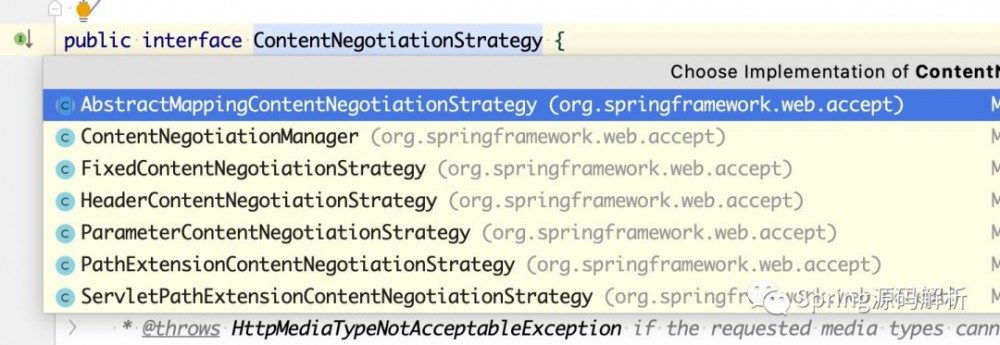内容协商 Spring ContentNegotiation
在SpringMVC中,我们访问一个 RESTful @ReponseBody 接口时,spring可以实现根据path extension来给出不同的响应格式,如:
// Json
curl http://localhost:8080/springautowired/foo.json
{"foo":"bar"}
// Xml
curl http://localhost:8080/springqutowired/foo.xml
<?xml version="1.0" encoding="UTF-8"?>
<root><foo>bar</foo></root>
这是spring内容协商的一种外在表现形式。
内容协商,ContentNegotiation 在spring中关注的核心问题是: 你想要什么样格式的数据 。 你想要什么,可以理解为, http请求响应时,服务器应该往http response body里写什么格式的数据 。
分层概念
在SpringMVC的概念中,View指的是数据的展现形式,Model可以理解成领域数据模型或者载体,MVC的核心是分层,分层的目的是为了解耦。就View与Model之间的解耦,指的是数据本身与数据展示形式的解耦,在spring应用内部,领域数据的载体,可以简单理解为bean。到了View层,数据的展现形式多种多样,可以是Jsp, velocity,pdf 或者RESTful的json, xml等。
使用SpringMVC时,通常有两种方式产生输出:
-
使用RESTful 的 @ ResponseBody,借助于HttpMessageConverter来输出像Json Xml等类型的的数据
-
使用 view resolution,可以生成更传统的Html页面(Jsp、Velocity等)
无论用哪种方式,你都有可能需要把Controller返回的相同的数据内容转成不同的表现形式。
在之前的内容中有提到HttpMessageConverter是spring处理rest请求时负责解析与转换http消息的逻辑单元。借助HttpMessageConverter,sping可以实现应用领域数据bean与http消息body的转换。 那么问题来了,当前一个http请求完成时,该用哪个具体的HttpMessageConverter实现来回写数据,这就是ContentNegotiation关注的内容。
协商策略
提到协商,必须有协商的点和策略,对应一个http请求,spring来判定请求中htto body格式主要通过以下三个因素(优先级同顺序):
-
path extension 也称为path suffix 就是文章开头提到的例子中的url后缀 .json .xml
-
url parameter 是一个明确指定媒体类型的参数,即通过显式的参数告诉服务器,我想要什么格式的数据。如format=json, 参数名可指定,默认是format
-
http header ( Accept) 如果上边两项都没有,能参考http header Accept来判定响应数据格式,因某些浏览器或者有些http请求不完全按规则来指定需要的媒体类型,所以使用时需要谨慎使用header
上述协商的规则,在spring中被抽象为接口:
// A strategy for resolving the requested media types
// for a request.
ContentNegotiationStrategy

-
FixContentNegotiationStrategy一般用来处理默认数据格式
-
HeaderContentNegotiationStrategy用来处理http Accept header的方式
-
ParameterContentNegotiationStrategy用来处理显式的媒体类型参数方式
-
PathExtensionContentNegotiationStrategy处理url后缀方式
上边这些strategy实现类以组合模式的形式封装成ContentNegotiationManager,对外提供逻辑接口。
ContentNegotiationManager的resolveMediaTypes方法如下:
@Override
public List<MediaType> resolveMediaTypes(NativeWebRequest request)
throws HttpMediaTypeNotAcceptableException {
for (ContentNegotiationStrategy strategy : this.strategies) {
List<MediaType> mediaTypes = strategy.resolveMediaTypes(request);
if (mediaTypes.isEmpty() || mediaTypes.equals(MEDIA_TYPE_ALL)) {
continue;
}
return mediaTypes;
}
return Collections.emptyList();
}
使用方式
在项目中,可以通过ContentNegotiationManagerFactoryBean来配置一个全局的内容协商contentNegotiationManager,给spring MVC使用,ContentNegotiationManagerFactoryBean中主要属性如下:
public class ContentNegotiationManagerFactoryBean
implements FactoryBean<ContentNegotiationManager>,
ServletContextAware, InitializingBean {
//是否关注url路径后缀
private boolean favorPathExtension = true;
//是否关注媒体参数
private boolean favorParameter = false;
//是否忽略http Accept header
private boolean ignoreAcceptHeader = false;
// url 后缀与媒体类型的映射
private Map<String, MediaType> mediaTypes =
new HashMap<String, MediaType>();
//忽略未知的后缀
private boolean ignoreUnknownPathExtensions = true;
// 默认的媒体参数名
private String parameterName = "format”;
可以这样定义一个contentNegotiationManager:
@Configuration
@EnableWebMvc
public class WebConfig extends WebMvcConfigurerAdapter {
@Override
public void configureContentNegotiation(ContentNegotiationConfigurer configurer) {
configurer.favorPathExtension(false).
favorParameter(true).
parameterName("mediaType").
ignoreAcceptHeader(true)
defaultContentType(MediaType.APPLICATION_JSON).
mediaType("xml", MediaType.APPLICATION_XML).
mediaType("json", MediaType.APPLICATION_JSON);
}
}
xml形式的配置:
<bean id="contentNegotiationManager"
class="org.springframework.web.accept.ContentNegotiationManagerFactoryBean">
<property name="favorPathExtension" value="false" />
<property name="favorParameter" value="true" />
<property name="parameterName" value="mediaType" />
<property name="ignoreAcceptHeader" value="true"/>
<property name="defaultContentType" value="application/json" />
<property name="mediaTypes">
<map>
<entry key="json" value="application/json" />
<entry key="xml" value="application/xml" />
</map>
</property>
</bean>
ContentNegotiation不仅限于Rest风格的http请求,SpringMVC中还有ContentNegotiatingViewResolver完成了viewResolver部分的内容协商功能,有兴趣的小伙伴可以查看部分的源码。
以上便是今天的全部内容,感谢关注,欢迎小伙伴留言反馈。
往期回顾:
-
Spring Environment Abstraction
-
Spring MVC 异常处理机制
-
Spring 重试机制实现原理
-
Spring Cache的使用及实现原理
-
Spring AOP 模块概述
-
Spring RestTemplate详解
-
Spring类型转换机制
-
Spring中的异步Servlet
-
玩转Spring bean的终极利器 Spring的注入方式大比拼
-
Spring bean生命周期不可不知的接口
SpringAutowired


长按,识别二维码,加关注
- 本文标签: root 数据模型 map Collection 解析 REST Action IDE Spring REST key web 生命 cat IO 重试机制 HTML 二维码 tab Property 数据 id XML spring http js cache equals App SpringMVC 源码 message UI MQ Collections src https ORM HashMap CTO list 服务器 文章 配置 AOP json 参数 servlet bean RESTful 模型 value
- 版权声明: 本文为互联网转载文章,出处已在文章中说明(部分除外)。如果侵权,请联系本站长删除,谢谢。
- 本文海报: 生成海报一 生成海报二











![[HBLOG]公众号](https://www.liuhaihua.cn/img/qrcode_gzh.jpg)

